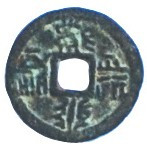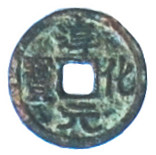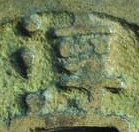Two rare ancient Chinese coins were recently discovered in northwest China’s Ningxia Hui Autonomous Region (宁夏回族自治区) according to an official government website.
According to an article on the Pengyang County (彭阳县) website published May 11, 2015, one coin is from the Western Xia (西夏 ) and the other coin is from the Northern Song dynasty.
Mr. Qi Yuezhang (祁悦章) with the Pengyang County Office of Chronicles Compilation (彭阳县史志办公室) is the author of the article. Based on his more than 10 years experience in cultural relics, he states that the coins are authentic.
The coins were obtained by a local Pengyang County coin collector from a Mr. Hu (虎姓) who lives in Mengyuan Village (孟塬乡).

Rare “Da An Bao Qian” coin from the Western Xia
Shown at the left is a rare coin minted during the Western Xia (xi xia 西夏 1038-1227).
The inscription is written in Tangut (xi xia wen 西夏文) which was the script used by the Tangut people who ruled during the Western Xia.
The inscription (Chinese translation) reads da an bao qian (大安宝钱) and the coin was cast during the years 1075-1085 of the reign (1068-1086) of Emperor Hui Zong (惠宗, 李秉常).
Unfortunately, the images of the coins published with the article are small. However, the coin appears to be the “slanted character” variety (斜字版).
This bronze coin has a blank reverse side and a diameter of 2.4 cm.

Rare variety of “Chun Hua Yuan Bao” coin from the Northern Song Dynasty
The second rare bronze coin, shown at the left, was cast during the years 990-994 of the reign of Emperor Tai Zong (太宗, 赵光义 976-997) of the Northern Song dynasty (959-1126).
The inscription is written in regular script (kai shu 楷书) and reads chun hua yuan bao (淳化元宝).
Chun hua yuan bao coins written in regular script are actually very common.
However, this particular coin is a very rare variety.
The radical (shui 氵), which resembles three vertical dots and is on the left side of the first character chun (淳) at the top of the coin, is “shortened” and does not extend all the way to the bottom of the character.

“Chun” character on common “Chun Hua Yuan Bao” coin
This may be easily seen by comparing the coin’s chun (淳) character with that of a “common” variety of chun hua yuan bao coin as displayed in the image at the left.
The coin is thus known to Chinese numismatists as the “shortened shui” or “shrunken shui” variety (suo shui ban 缩水版) and very few authentic specimens are known to exist.
According to legend, Emperor Tai Zong personally did the calligraphy for the chun hua yuan bao coin inscription. For this reason, the coin is known as “royally inscribed currency” (yu shu qian 御书钱).
Pengyang County is located in the territory once ruled by the Western Xia and large quantities of both Western Xia and Song dynasty coins have been excavated in the area.
Not surprisingly, more than half of the ancient coins in the collection of the Pengyang County Office of Cultural Relics (彭阳县文物馆) date from the Western Xia and Song dynasty.